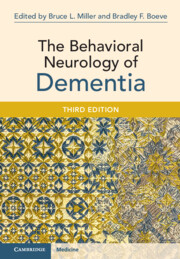
-
Select format
-
- Publisher:
- Cambridge University Press
- Publication date:
- August 2025
- December 2025
- ISBN:
- 9781108985055
- 9781108833516
- Dimensions:
- (254 x 178 mm)
- Weight & Pages:
- 0.5kg, 520 Pages
- Dimensions:
- Weight & Pages:
You may already have access via personal or institutional login
Book description
Most people who develop dementia will never be diagnosed, and therefore lack access to treatment and care from specialists in the field. This new edition provides updated guidance on how behavioral symptom reflect the changes occurring in the brain, and how these can help generalist clinicians to accurately diagnose neurodegenerative diseases. This practical book is aimed at healthcare professionals working in neurology, psychiatry and neuropsychology wanting to enhance the skills and knowledge needed to successfully manage these diseases. Simple approaches to bedside mental status testing, differential diagnosis and treatment, and interpreting neuropsychological testing and neuroimaging findings are covered. Introductory chapters outline dementia epidemiology and dementia neuropathology whilst chapters new to this edition describe the improvements in diagnostic capabilities in recent years, including blood based and cerebrospinal biomarkers and emerging biologically based therapies. Chapters on sleep disorders, and chronic traumatic encephalopathy and traumatic brain injury have also been expanded.
Contents
Metrics
Full text views
Full text views help Loading metrics...
Loading metrics...
* Views captured on Cambridge Core between #date#. This data will be updated every 24 hours.
Usage data cannot currently be displayed.
Accessibility standard: WCAG 2.1 AA
Why this information is here
This section outlines the accessibility features of this content - including support for screen readers, full keyboard navigation and high-contrast display options. This may not be relevant for you.
Accessibility Information
The PDF of this book complies with version 2.1 of the Web Content Accessibility Guidelines (WCAG), covering newer accessibility requirements and improved user experiences and achieves the intermediate (AA) level of WCAG compliance, covering a wider range of accessibility requirements.
Content Navigation
Table of contents navigation
Allows you to navigate directly to chapters, sections, or non‐text items through a linked table of contents, reducing the need for extensive scrolling.
Index navigation
Provides an interactive index, letting you go straight to where a term or subject appears in the text without manual searching.
Reading Order and Textual Equivalents
Single logical reading order
You will encounter all content (including footnotes, captions, etc.) in a clear, sequential flow, making it easier to follow with assistive tools like screen readers.
Short alternative textual descriptions
You get concise descriptions (for images, charts, or media clips), ensuring you do not miss crucial information when visual or audio elements are not accessible.
Visual Accessibility
Use of colour is not sole means of conveying information
You will still understand key ideas or prompts without relying solely on colour, which is especially helpful if you have colour vision deficiencies.
Structural and Technical Features
ARIA roles provided
You gain clarity from ARIA (Accessible Rich Internet Applications) roles and attributes, as they help assistive technologies interpret how each part of the content functions.

